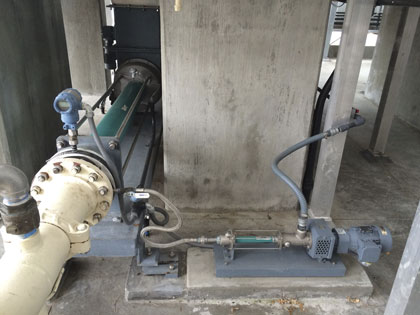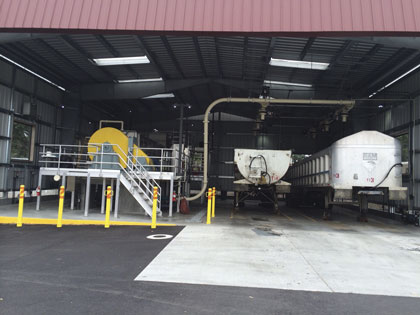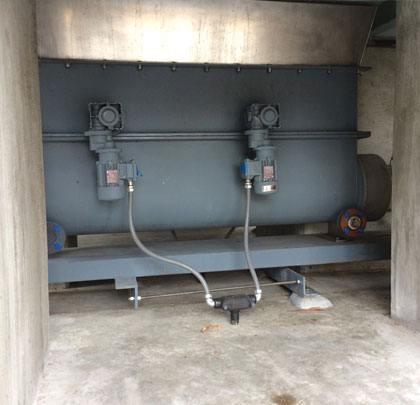Last month, we started an examination of a major sludge handling upgrade by California’s Sonoma County Water Agency (SCWA), specifically replacing their existing sludge belt press/conveyor technology. In this article, we’ll follow SCWA’s installation of NETZSCH screw press technology, specifically designed to convey dewatered sludge easily. As we’ll see, SCWA has customized the solution to meet their specific needs in part by including an asynchronous bridge prevention (aBP) module to prevent sludge “bridging” as well as a friction loss reduction (FLR) system.

Featured Image: Figure 2: The aBP module essentially makes a moving wall in the chute, preventing the material from building up on the walls.
Above: Figure 3 – The FLR system consists of a small progressing cavity pump that injects a layer of polymer along the outer diameter of the pipe.
ASYNCHRONOUS BRIDGE PREVENTION (aBP) MODULE
Also included was an asynchronous bridge prevention (aBP) module to prevent sludge “bridging” in the chute below the screw press, which could then block the inlet to the pump. Bridging occurs when thick and dry dewatered sludge cakes together. If sticky enough, it can build up on the walls of the chute and then actually “bridge” over the top of the auger in the pump, stick to itself, and not drop down with gravity into the pump.
The aBP module, shown on figure 2, consists of two flat spoked wheels, one on each long side of the chute. It has its own small (¼-horsepower) motor, which turns very slowly. The module essentially makes a moving wall in the chute, preventing the material from building up on the walls, because the flat large diameter wheels turn very slowly at slightly different speeds from one another. Installation of the aPB allowed the sludge cake pump to handle even the stickiest, most bridge-prone sludge.
The project was initially planned for construction in 2012 but was delayed for budgetary reasons. The equipment was delivered and the installation was completed, with facility startup in the January of 2014. NETZSCH provided the pump to the contractor, FKC provided the screw press, and the contractor installed all the equipment, all the piping work, and the building construction. Flo-Line Technology assisted with the development, design, commissioning, and system optimization, offering a turnkey solution to the client.

Figure 4: The loading bay in operation
WORKING OUT THE KINKS
After operations began, the District experienced a significantly high pressure drop, which resulted in some difficulty pumping the muddy dirt-like material through the very long spans to the trailers sitting side by side in the new sludge loading building. There were three spots they could dump sludge in each trailer. The system included six valves—three for each truck. The spot farthest away required a pressure of 360 pounds per square inch (psi). While technically feasible, such a pressure was higher than the pump’s intended design, and might have resulted in very high wear and relatively short life.
The District requested recommendations for fixing the situation. The initial suggestion of replacing the facility’s 6-inch glass-lined pipes (used because it is smooth on the inside to reduce friction) with 8-inch pipes would have been extremely costly. The ultimate solution included changing the elbows used for changing direction from a tight bend to very long radius elbows, thus reducing significant pressure losses in the elbows.
The District also added a friction loss reduction (FLR) system, which essentially produces a slippery layer on the walls of the pipe to reduce friction.
Using a ring nozzle, the FLR system provides a continuous 360° even layer around the entire pipe surface that reduces friction loss within the pipeline and allows for pressure reductions of up to 50 percent. This let the District achieve considerable reductions in pressure, cutting back on operating costs and improving system lifetime. As a result of these changes, the pressure experienced at the valve farthest away from the pump is now 220 psi, a roughly one third drop in pressure loss. The pressure is now in line with the original design considerations.
According to John Albrecht, SCWA’s Maintenance Supervisor, the pumps have been performing very well for more than a year of operations, with very low maintenance and easy availability of parts. “My job is to make things run and stay running, and the quality of these pumps is high. They are reliable, easy to run, and very accurate. You dial up the percentage and know exactly what it will be, with no variation in the gallon per minute discharge. They also have run-dry protection, with a thermocouple on the stator that shuts it down if it is too hot. We got the kinks worked out well and it is a very robust system that does what it is supposed to do.” ◆
About the Author:
Jeff Helm is western regional manager for NETZSCH Pumps North America, LLC, and Greg Scott is sales engineer for Flo-Line Technology Inc. For more information, visit www.netzschusa.com and www.flolinepumps.com.
____________________________________________
MODERN PUMPING TODAY, June 2016
Did you enjoy this article?
Subscribe to the FREE Digital Edition of Modern Pumping Today Magazine!
![]()


